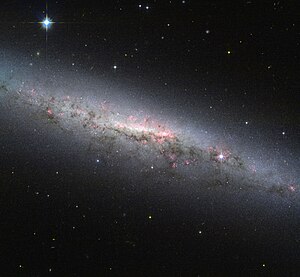NGC 7090
| Galaxie NGC 7090 | |
|---|---|
 | |
| Aufnahme des Hubble-Weltraumteleskops | |
| AladinLite | |
| Sternbild | Indus |
| Position Äquinoktium: J2000.0, Epoche: J2000.0 | |
| Rektaszension | 21h 36m 28,86s[1] |
| Deklination | −54° 33′ 26,4″[1] |
| Erscheinungsbild | |
| Morphologischer Typ | SBc?[1] |
| Helligkeit (visuell) | 10,7 mag[2] |
| Helligkeit (B-Band) | 11,4 mag[2] |
| Winkelausdehnung | 7,3' × 1,2'[2] |
| Positionswinkel | 127°[2] |
| Flächenhelligkeit | 12,9 mag/arcmin²[2] |
| Physikalische Daten | |
| Zugehörigkeit | isoliert[1] |
| Rotverschiebung | 0,002825 ± 0,000010[1] |
| Radialgeschwindigkeit | (847 ± 3) km/s[1] |
| Hubbledistanz H0 = 73 km/(s • Mpc) | (36 ± 3) · 106 Lj (10,9 ± 0,8) Mpc [1] |
| Geschichte | |
| Entdeckung | John Herschel |
| Entdeckungsdatum | 4. Oktober 1834 |
| Katalogbezeichnungen | |
| NGC 7090 • PGC 67045 • ESO 188-12 • IRAS 21329-5446 • 2MASX J21362886-5433263 • SGC 213259-5446.9 • AM 2133-544 • GC 4679 • h 3872 • GALEXMSC J213629.22-543328.8 • HIPASS J2136-54 • 2MIG 2930 • WISEA J213628.81-543325.2 | |
NGC 7090 ist eine Balken-Spiralgalaxie vom Hubble-Typ SBc im Sternbild Indianer am Südsternhimmel. Sie ist schätzungsweise 36 Millionen Lichtjahre von der Milchstraße entfernt und hat einen Durchmesser von etwa 85.000 Lichtjahren.
Das Objekt wurde am 4. Oktober 1834 vom britischen Astronomen John Herschel entdeckt.[3]
Weblinks
- SIMBAD Astronomical Database
- NGC 7090 — An actively star-forming galaxy (engl.)
- Spektrum.de: Amateuraufnahmen [1]
Einzelnachweise
Auf dieser Seite verwendete Medien
This image portrays a view of the galaxy NGC 7090, as seen by the NASA/ESA Hubble Space Telescope. The galaxy is viewed edge-on from the Earth, meaning we cannot easily see the spiral arms, which are full of young, hot stars. However, a side-on view shows the galaxy’s disc and the bulging central core, where typically a large group of cool old stars are packed in a compact, spheroidal region. In addition, there are two interesting features present in the image that are worth mentioning:
First, we are able to distinguish an intricate pattern of pinkish red regions over the whole galaxy. This indicates the presence of clouds of hydrogen gas. These structures trace the location of ongoing star formation, visual confirmation of recent studies that classify NGC 7090 as an actively star-forming galaxy.
Second, we observe dust lanes, depicted as dark regions inside the disc of the galaxy. In NGC 7090, these regions are mostly located in lower half of the galaxy, showing an intricate filamentary structure. Looking from the outside in through the whole disc, the light emitted from the bright center of the galaxy is absorbed by the dust, silhouetting the dusty regions against the bright light in the background.
The image was taken using the Wide Field Channel of the Advanced Camera for Surveys aboard the Hubble Space Telescope and combines orange light (colored blue here), infrared (colored red) and emissions from glowing hydrogen gas (also in red).
A version of this image of NGC 7090 was entered into the Hubble’s Hidden Treasures Image Processing Competition by contestant Rasid Tugral.